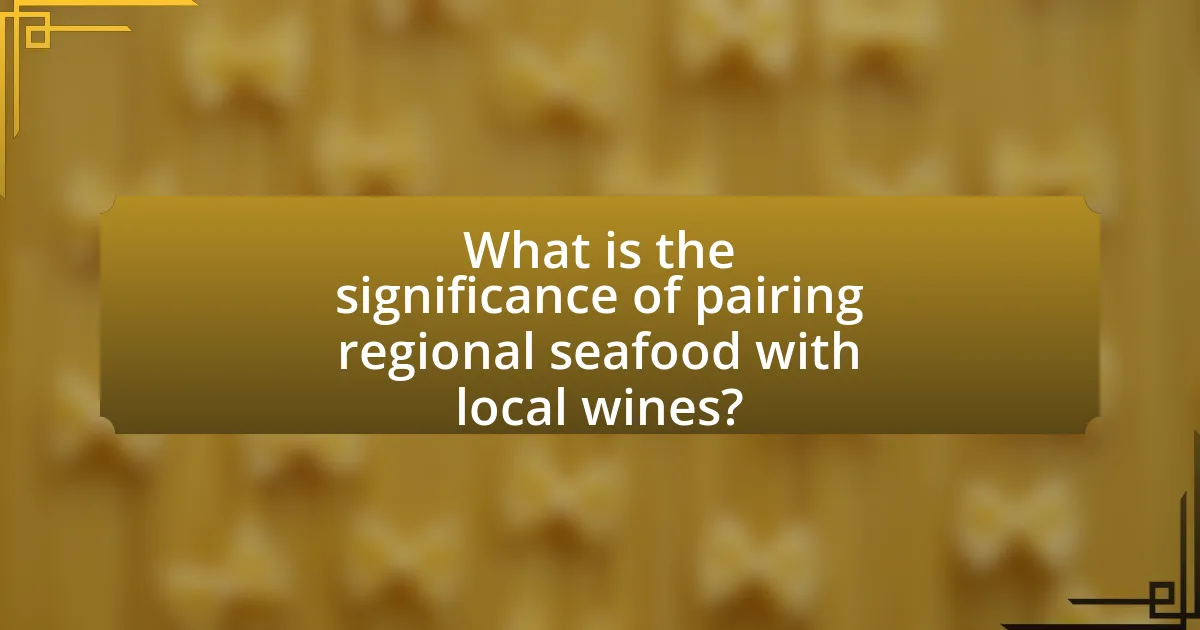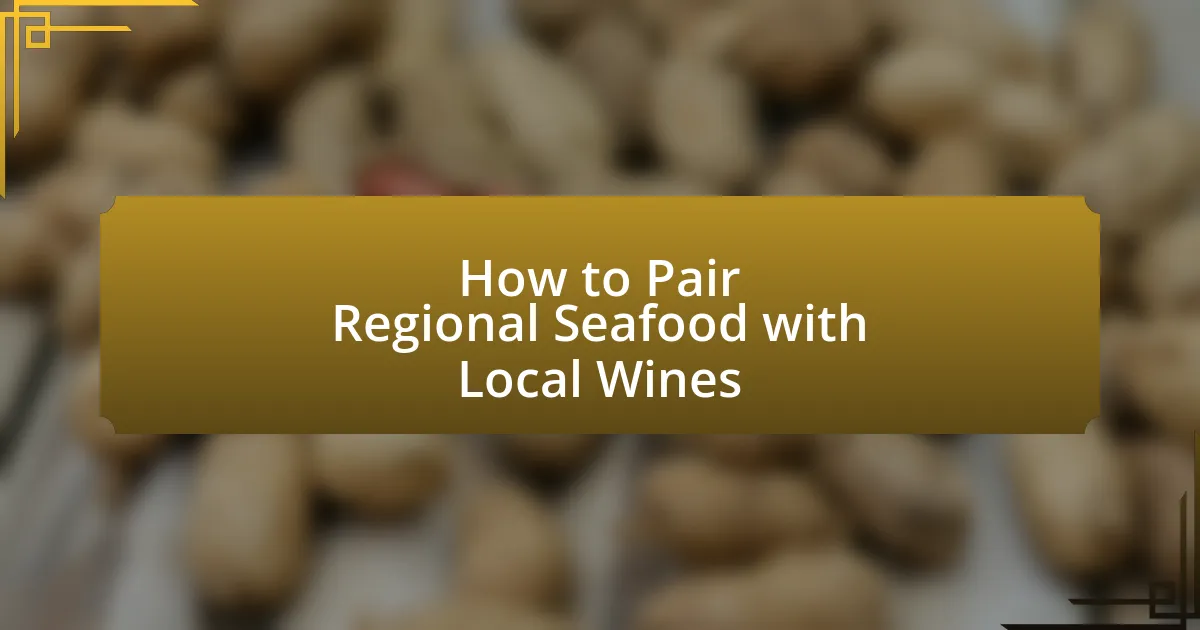The article focuses on the significance of pairing regional seafood with local wines, emphasizing how this practice enhances the dining experience by complementing flavors and supporting local culinary traditions. It explores the influence of seafood origin on wine pairing, highlighting how flavor profiles, textures, and preparation methods dictate suitable wine choices. Additionally, the article discusses the importance of seasonality in selecting seafood and wines, as well as the basic principles of pairing, including the roles of acidity and sweetness. It provides examples of successful regional pairings and offers tips for optimizing the pairing experience, ultimately fostering a deeper connection between local food and wine.

What is the significance of pairing regional seafood with local wines?
Pairing regional seafood with local wines enhances the dining experience by complementing flavors and promoting local culinary traditions. This significance arises from the fact that local wines are often crafted to match the specific taste profiles of the seafood available in the region, creating a harmonious balance. For instance, coastal areas typically produce white wines that pair well with the lighter, briny flavors of seafood, while red wines from the same region may enhance richer seafood dishes. Additionally, this practice supports local economies and encourages sustainable fishing and winemaking practices, fostering a connection between the land and sea.
How does the origin of seafood influence wine pairing?
The origin of seafood significantly influences wine pairing by determining the flavor profile and texture of the seafood, which in turn affects the compatibility with various wines. For instance, seafood from colder waters, such as Pacific Northwest salmon, tends to have a richer, oilier texture, making it well-suited for fuller-bodied white wines like Chardonnay. Conversely, seafood from warmer waters, such as Mediterranean fish, often has a lighter, more delicate flavor, pairing better with crisp, acidic wines like Sauvignon Blanc. This relationship is supported by the principle that regional wines often complement local seafood due to shared environmental factors, such as soil and climate, which shape both the seafood’s characteristics and the wine’s flavor profile.
What characteristics of regional seafood affect wine choices?
The characteristics of regional seafood that affect wine choices include flavor profiles, texture, and preparation methods. Flavor profiles, such as the brininess of oysters or the sweetness of shrimp, influence the selection of wines that can complement or contrast these tastes effectively. For instance, the high salinity of coastal seafood often pairs well with crisp, acidic white wines like Sauvignon Blanc, which can enhance the seafood’s natural flavors. Texture also plays a crucial role; delicate fish like sole may be better suited to lighter wines, while richer seafood like salmon can handle fuller-bodied wines such as Chardonnay. Additionally, preparation methods, such as grilling or frying, can alter the flavor and texture, prompting different wine pairings; grilled seafood often pairs well with wines that have a smoky or oaky character. These factors collectively guide the choice of wine to achieve a harmonious dining experience.
How do local wine varieties complement specific seafood types?
Local wine varieties enhance specific seafood types by matching flavor profiles and acidity levels. For instance, a crisp Sauvignon Blanc from a coastal region pairs well with oysters due to its high acidity and citrus notes, which complement the briny taste of the oysters. Similarly, a light-bodied Pinot Grigio can enhance the delicate flavors of white fish, as its subtle fruitiness does not overpower the dish. Research indicates that wines with similar regional origins to the seafood often create harmonious pairings, as they share common environmental influences that shape their flavors.
Why is it important to consider seasonality in seafood and wine pairing?
Considering seasonality in seafood and wine pairing is crucial because it enhances flavor compatibility and ensures freshness. Seasonal seafood is typically at its peak quality, offering better taste and texture, which directly influences the overall dining experience. For instance, pairing a light, crisp white wine with fresh summer catch like flounder or halibut complements the delicate flavors of the fish. Additionally, wines produced in the same region as the seafood often reflect the local terroir, creating a harmonious balance. Research indicates that seasonal ingredients not only taste better but also support sustainable practices by reducing the carbon footprint associated with transportation.
What seasonal seafood options are available in different regions?
Seasonal seafood options vary by region, with specific types available during different times of the year. For example, in the Northeast United States, lobster is abundant in summer, while scallops are typically harvested in the fall. The Pacific Northwest offers salmon in summer and Dungeness crab in winter. In the Gulf of Mexico, shrimp is plentiful in late spring and summer, while oysters are best from fall to early spring. The Mediterranean region features anchovies in spring and sardines in summer. These seasonal patterns are influenced by local fishing regulations and environmental conditions, ensuring sustainability and freshness.
How does seasonality impact the flavor profiles of wines?
Seasonality significantly impacts the flavor profiles of wines by influencing grape ripening, acidity levels, and aromatic compounds. During warmer months, grapes tend to accumulate more sugars, resulting in wines with higher alcohol content and riper fruit flavors. Conversely, cooler seasons can lead to higher acidity and more restrained flavors, producing wines that are fresher and more vibrant. For example, studies show that grapes harvested in cooler climates often exhibit more floral and herbal notes, while those from warmer regions may present bolder, jammy characteristics. This seasonal variation is crucial for winemakers to consider when pairing wines with regional seafood, as the flavor profiles of both the wine and the seafood can complement or contrast effectively based on the season.
What are the basic principles of pairing seafood with wine?
The basic principles of pairing seafood with wine involve matching the wine’s acidity, body, and flavor profile to the characteristics of the seafood. Generally, white wines, particularly those with higher acidity like Sauvignon Blanc or Pinot Grigio, complement lighter seafood such as white fish and shellfish, enhancing their delicate flavors. In contrast, richer seafood like salmon pairs well with fuller-bodied white wines or light reds, such as Chardonnay or Pinot Noir, which can stand up to the fish’s oiliness. This approach is supported by the fact that acidity in wine can cut through the richness of seafood, creating a balanced taste experience.
How do acidity and sweetness play a role in pairing?
Acidity and sweetness are crucial in pairing because they influence the balance and harmony of flavors between food and wine. High acidity in wine can enhance the freshness of seafood, cutting through rich or fatty textures, while sweetness can complement the natural sweetness of certain seafood, such as shellfish. For example, a crisp, acidic white wine like Sauvignon Blanc pairs well with oysters, as its acidity accentuates the brininess of the seafood. Conversely, a slightly sweet wine, such as a Riesling, can enhance the flavors of grilled shrimp, creating a pleasing contrast. This principle is supported by the concept of balance in culinary pairings, where acidity brightens dishes and sweetness rounds out flavors, leading to a more enjoyable dining experience.
What are the common flavor profiles of seafood and wines?
Seafood typically exhibits flavor profiles that are briny, sweet, and umami, often characterized by freshness and a delicate texture. Common seafood varieties like shrimp, scallops, and white fish have subtle flavors that can be enhanced by cooking methods and seasonings. In contrast, wines often present profiles that range from crisp and acidic to rich and fruity, with white wines like Sauvignon Blanc and Chardonnay complementing the lightness of seafood through their acidity and fruit notes. Red wines, such as Pinot Noir, can also pair well with certain seafood, particularly richer varieties like salmon, due to their balanced tannins and fruitiness. The interaction between the briny, sweet, and umami notes of seafood and the acidity and fruitiness of wines creates harmonious pairings that enhance the dining experience.
How can one transition from general pairing principles to specific pairings?
To transition from general pairing principles to specific pairings, one must analyze the flavor profiles of both the seafood and the local wines. This involves identifying the dominant flavors, textures, and aromas in the seafood, such as the sweetness of scallops or the brininess of oysters, and matching them with wines that complement or contrast these characteristics, like a crisp Sauvignon Blanc for oysters or a buttery Chardonnay for scallops. Research indicates that successful pairings enhance the dining experience by balancing acidity, sweetness, and umami, as seen in studies on flavor interactions in food and wine pairings.
What factors should be considered when selecting local wines for seafood?
When selecting local wines for seafood, consider the wine’s acidity, flavor profile, and regional compatibility. High acidity in wines, such as Sauvignon Blanc or Albariño, complements the natural salinity of seafood, enhancing its flavors. Additionally, the flavor profile should match the seafood type; for instance, light-bodied wines pair well with delicate fish, while fuller-bodied wines suit richer seafood like salmon. Regional compatibility is crucial, as local wines often reflect the terroir that influences the seafood’s taste, creating a harmonious pairing. For example, pairing local coastal wines with freshly caught fish from the same region maximizes flavor synergy.
What are some popular regional seafood and wine pairings?
Popular regional seafood and wine pairings include Muscadet with oysters in the Loire Valley, Sauvignon Blanc with grilled fish in New Zealand, and Chardonnay with lobster in Maine. These pairings are based on the principle that the wine’s acidity and flavor profile complement the seafood’s texture and taste. For instance, Muscadet’s crispness enhances the brininess of oysters, while Sauvignon Blanc’s citrus notes elevate the flavors of grilled fish. Chardonnay’s richness matches the buttery texture of lobster, making these combinations widely celebrated in their respective regions.
How do specific regions influence the best pairings?
Specific regions influence the best pairings by determining the flavor profiles and characteristics of both seafood and local wines. For example, coastal regions often produce seafood that is fresh and briny, which pairs well with crisp, acidic wines like Sauvignon Blanc, commonly found in regions such as Marlborough, New Zealand. Additionally, the terroir of a region affects the grape varieties grown, leading to unique wine flavors that complement local seafood. In regions like the Mediterranean, where both seafood and wines are influenced by the same climate and soil, traditional pairings have evolved, such as pairing grilled octopus with Assyrtiko from Santorini. These regional characteristics create harmonious pairings that enhance the dining experience.
What are examples of successful pairings from various regions?
Successful pairings of regional seafood with local wines include the following: in the Pacific Northwest, salmon is often paired with Pinot Noir, which complements the fish’s rich flavors; in New England, lobster is frequently enjoyed with Chardonnay, enhancing the sweetness of the lobster; in the Mediterranean, grilled octopus pairs well with Assyrtiko, a white wine that balances the dish’s saltiness; and in the Gulf Coast, shrimp and grits are commonly served with a dry Riesling, which offsets the dish’s creaminess. These pairings are based on the flavor profiles of the seafood and the characteristics of the wines, creating harmonious dining experiences.
What tips can enhance the experience of pairing regional seafood with local wines?
To enhance the experience of pairing regional seafood with local wines, focus on matching the wine’s acidity and flavor profile with the seafood’s characteristics. For instance, lighter seafood like sole or flounder pairs well with crisp white wines such as Sauvignon Blanc, which has high acidity that complements the delicate flavors. Conversely, richer seafood like salmon can be paired with fuller-bodied whites or light reds, such as Chardonnay or Pinot Noir, which can balance the richness. Additionally, consider the preparation method; grilled seafood often pairs better with wines that have a smoky or oaky profile. This approach is supported by the principle that acidity in wine enhances the freshness of seafood, creating a harmonious dining experience.

Leave a Reply